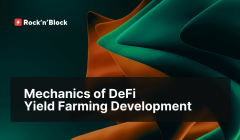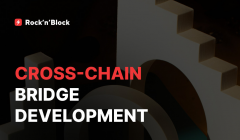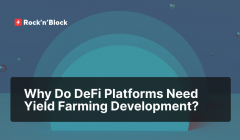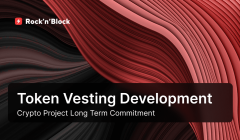Exploring Vesting Schedules: Types and Tips
03 May 2024Vesting schedules play a pivotal role in shaping token distribution, incentivizing stakeholders, and ensuring project sustainability. Understanding the intricacies of vesting schedules is crucial for project founders and developers, investors, and participants alike. In this article, we delve into the depths of vesting schedules, exploring various types and offering valuable insights. Whether you're embarking on a new project or seeking to optimize existing vesting structures, this deep dive into vesting development will provide you with the insights and strategies needed to navigate this essential aspect of cryptocurrency ventures.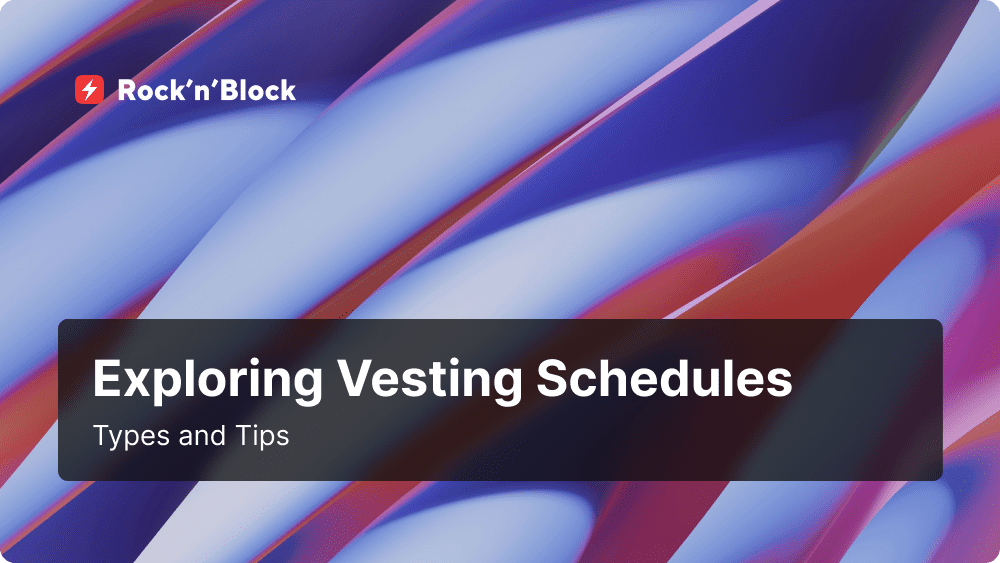
Table of Contents:
-
Introduction to Vesting Development in Cryptocurrency
-
Token Vesting Schedules and Their Types
-
⚙️ 1. Linear Vesting Development
-
🎯 2. Milestone-Based Vesting Development
-
⏫️ 3. Back-Weighted Vesting Development
-
🧮 4. Graded Vesting Development
-
⏰ 5. Time-Based Vesting Development
-
🏔️ 6. Cliff Vesting Development
-
🖌️ 7. Hybrid Vesting Models Development
-
-
Conclusion
Introduction to Vesting Development in Cryptocurrency
At its core, vesting development refers to the process through which individuals or entities gradually gain ownership of assets or benefits over a specified period. In the context of cryptocurrency, vesting commonly involves the gradual release of tokens or coins to project contributors, team members, advisors, or investors. Unlike immediate distribution, vesting schedules impose certain conditions or time frames before recipients can access their allocated tokens fully.
Vesting mechanisms aim to incentivize long-term commitment, align interests between stakeholders, and mitigate the risks of token dumping or sudden market fluctuations. By introducing lockup periods, vesting instills trust and stability within the ecosystem, fostering trust and confidence among participants. This is especially important when launching your crypto web3 startup, as it ensures sustained stakeholder engagement and commitment, laying a solid foundation for long-term success.
Importance of Vesting Development in Crypto Projects
The significance of token vesting platform development for crypto projects cannot be overstated, as it serves various critical purposes that contribute to their sustainability and success:
1. Stability and Long-Term Perspective: Vesting provides stability by discouraging short-term speculation and encouraging long-term commitment among participants. Tokens with lockup periods encourage holders to remain engaged with the project and contribute to its development and growth over time.
2. Alignment of Incentives: By implementing vesting schedules, cryptocurrency projects align the incentives of team members, advisors, investors, and other stakeholders with the project's long-term objectives. When tokens are gradually released based on performance milestones or predetermined timelines, participants are incentivized to work towards the project's success, fostering a collaborative and cohesive ecosystem.
3. Prevention of Token Dumping: Vesting development can help prevent token dumping. Token dumping is the rapid selling of tokens by stakeholders, often resulting in a significant drop in token value, market instability and destabilization of the project. By timing the release of tokens, vesting minimizes the risk of sudden sell-offs, thereby maintaining price stability and investor confidence.
4. Risk Mitigation: In the volatile world of cryptocurrency, risk mitigation is paramount. Vesting development mechanisms provide a layer of protection against various risks, including team member rug pool, market manipulation, and fraudulent activities. By gradually releasing tokens and imposing conditions for their distribution, vesting safeguards the project's integrity and sustainability.
5. Project Credibility: Transparent and well-structured vesting schedules enhance the credibility of the project, demonstrating a commitment to fairness, accountability, and long-term value creation. This can attract more investors and partners to the project.
Check out our related article: How to Build Vesting Smart Contract!
Token Vesting Schedules and Their Types
Token vesting schedules detail the terms and conditions for releasing tokens to recipients over time. These schedules align with the goals and milestones of the cryptocurrency project while incentivizing long-term engagement and commitment. The vesting schedule duration in cryptocurrency projects can vary depending on factors such as project goals, tokenomics design, and stakeholder interests. Common durations range from several months to several years, although there is no standard timeframe for vesting schedules. The cryptocurrency space commonly employs several types of token vesting schedules:
⚙️ 1. Linear Vesting Development
Definition and Concept
Linear vesting is a vesting development model where tokens are released in equal increments over regular intervals until full token allocation is released. Unlike other vesting models that may frontload or backload token release, linear vesting offers a simple and predictable approach by distributing tokens evenly throughout the vesting period.
How Linear Vesting Works
In linear vesting development, tokens are released according to a predefined schedule that outlines the increments and intervals for token distribution. For example, a linear vesting schedule might stipulate that 1/50th of allocated tokens become available each week for 50 weeks until full vesting is achieved. By distributing tokens evenly over time, linear vesting provides recipients with a predictable and structured release of tokens, promoting transparency and fairness within the ecosystem.
✅ Pros:
-
Transparency and Fairness: Linear vesting development provides transparency and fairness by distributing tokens evenly over time, promoting equity and inclusivity within the ecosystem.
-
Predictability: By offering a predictable and structured release of tokens, linear vesting enhances stability and predictability within the ecosystem, reducing the risk of sudden market fluctuations.
🚨 Cons:
-
Limited Flexibility: Linear vesting development may offer less flexibility compared to other vesting models, as token release is predetermined and structured according to a linear schedule.
-
Potential for Disengagement: Extended vesting periods may discourage participation or engagement among recipients, particularly if they perceive the wait time as excessive.
🎯 2. Milestone-Based Vesting Development
Definition and Concept
Milestone-based vesting development entails the gradual release of tokens to recipients based on the attainment of specific performance milestones or objectives. Unlike time-based or cliff vesting, which rely solely on the passage of time, milestone-based vesting aligns token release with the project's progress and development milestones. This approach aims to incentivize active participation, reward contributors based on their impact, and ensure that token release is tied to tangible project achievements.
How Milestone-Based Vesting Works
In milestone-based vesting, tokens are released incrementally as predetermined milestones are met. For example, tokens may be allocated to team members or advisors with the condition that a certain percentage becomes accessible upon the completion of each milestone. These milestones could include product development milestones, partnership agreements, network growth targets, or other key performance indicators relevant to the project's success. By tying token release to specific achievements, milestone-based vesting encourages stakeholders to contribute towards the project's advancement and success.
KPI Vesting
A variation of milestone-based vesting is KPI (Key Performance Indicator) vesting. In KPI vesting, tokens are released incrementally as specific performance milestones or KPIs are met. These milestones can be categorized into micro KPIs, which are project-specific and directly related to development and adoption, and macro KPIs, which encompass broader market and ecosystem indicators. For example, micro KPIs may include exchange listings, partnership announcements, dApp development updates, or app launches, while macro KPIs may include Bitcoin price, altcoin market cap, or the growth of infrastructure protocols. By tying token release to the achievement of measurable milestones, KPI vesting incentivizes project development, adoption, and growth.
✅ Pros:
-
Aligned Incentives: Milestone-based vesting development aligns token release with project milestones or performance metrics, incentivizing achievement and progress within the ecosystem.
-
Transparency and Accountability: By tying token release to specific milestones or KPIs, milestone-based vesting development promotes transparency and accountability, ensuring that token distribution is contingent upon measurable project progress.
🚨 Cons:
-
Subjectivity: Defining and evaluating milestones or KPIs may be subjective and open to interpretation, potentially leading to disagreements or disputes among stakeholders.
-
Complexity: Managing and enforcing milestone-based vesting schedules can be complex, requiring robust mechanisms to track performance metrics and ensure compliance with predefined milestones.
⏫️ 3. Back-Weighted Vesting Development
Definition and Concept
Back-weighted vesting is a method used in compensation and incentive plans where a larger portion of benefits or rewards is granted to individuals in later years or stages of their involvement, with the intention of encouraging long-term commitment and retention.
How Back-weighted Vesting Works
In a back-weighted vesting structure, the distribution of benefits is front-loaded with smaller rewards initially, followed by increasingly larger allocations over time. This design aligns with the principle that individuals who stay with a company or project for an extended period contribute more value and should be appropriately rewarded for their dedication and loyalty.
✅ Pros:
-
Long-Term Commitment: Back-weighted vesting encourages long-term commitment and retention of employees or stakeholders by offering larger rewards or benefits over time.
-
Motivation for Performance: By linking a larger portion of benefits to later years or stages, back-weighted vesting motivates individuals to consistently perform and deliver results over the duration of their involvement. This can lead to sustained effort and productivity.
🚨 Cons:
-
Delayed Gratification: Back-weighted vesting may result in delayed gratification for participants, as they receive a smaller portion of benefits initially and must wait for larger rewards to be unlocked over time. This could potentially lead to dissatisfaction or frustration, especially if individuals have short-term financial needs or expectations.
-
Retention Challenges: While back-weighted vesting aims to promote long-term commitment, it may not always effectively prevent turnover or attrition, as individuals may still choose to leave the organization before fully vesting their benefits for various reasons such as job dissatisfaction or external opportunities.
🧮 4. Graded Vesting Development
Definition and Concept
Graded vesting is a vesting development model where tokens are released in a series of predetermined increments over time, rather than in a single lump sum or through gradual linear release. Unlike traditional vesting models, which may front load or back load token release, graded vesting aims to provide a balanced approach by distributing tokens in equal or varying proportions at regular intervals.
How Graded Vesting Works
In graded vesting development, tokens are released according to a predefined schedule that outlines the increments and intervals for token distribution. For example, a graded vesting schedule might stipulate that 20% of allocated tokens become available after the first year, followed by 20% in the second year, 30% in the third year, and so forth.
✅ Pros:
-
Predictability: Graded vesting development provides a predictable and structured release of tokens, enhancing stability and predictability within the ecosystem.
-
Balanced Distribution: By distributing tokens in graded increments, graded vesting ensures a balanced approach to token distribution, incentivizing ongoing engagement and contribution.
🚨 Cons:
-
Limited Flexibility: Graded vesting development may offer less flexibility compared to other vesting models, as token release is predetermined and structured according to a predefined schedule.
-
Potential for Disengagement: Extended vesting periods may discourage participation or engagement among recipients, particularly if they perceive the wait time as excessive.
⏰ 5. Time-Based Vesting Development
Definition and Concept
Time-based vesting development refers to a mechanism where tokens are released to recipients gradually over a specified period, typically based solely on the passage of time. Unlike other vesting models that may tie token release to performance metrics or milestones, time-based vesting simply requires recipients to wait for a predetermined duration before gaining access to their token allocations.
How Time-Based Vesting Works
The mechanics of time-based vesting are relatively straightforward. Upon the issuance of tokens, recipients are subject to a vesting schedule that delineates the timeline for token release. For example, a time-based vesting schedule might stipulate that 25% of allocated tokens become available after the first year, with an additional 25% released each subsequent year until full vesting is achieved. Recipients must wait for the specified periods to elapse before gaining access to their tokens, regardless of their level of contribution or project milestones.
✅ Pros:
-
Simple and Predictable: Time-based vesting development offers a straightforward and predictable approach to token release, making it easy to understand and implement for both issuers and recipients.
-
Consistent Engagement: By releasing tokens gradually over time, time-based vesting encourages consistent engagement and commitment from recipients, promoting long-term involvement with the project.
🚨 Cons:
-
Limited Flexibility: Time-based vesting development may lack flexibility in accommodating changes in project milestones or recipient circumstances, as token release is solely based on the passage of time.
-
Potential for Early Dumping: Recipients may choose to sell their tokens immediately upon vesting, leading to potential market volatility or downward pressure on token prices.
🏔️ 6. Cliff Vesting Development
Definition and Concept
Cliff vesting development represents a vesting model where recipients must wait for a specified period, known as the cliff period, before gaining access to any portion of their allocated tokens. Unlike time-based vesting, which releases tokens gradually over time, cliff vesting imposes a single, substantial delay before any tokens are accessible.
How Cliff Vesting Works
In cliff vesting development, tokens remain locked until the expiration of the cliff period, after which they become fully accessible to recipients. For example, a cliff vesting schedule might stipulate that tokens are locked for one year, with full vesting occurring upon the completion of the cliff period. Recipients must remain committed to the project during the cliff period to access their allocated tokens, thereby aligning their interests with the project's long-term success.
✅ Pros:
-
Immediate Liquidity: Cliff vesting development provides recipients with immediate access to their allocated tokens after the expiration of the cliff period, offering liquidity and flexibility.
-
Simplified Administration: Cliff vesting development simplifies administrative processes by condensing token release into a single event, reducing the complexity of tracking and managing vesting schedules.
🚨 Cons:
-
Risk of Disengagement: Extended cliff periods may discourage participation or engagement among recipients, as they must wait for a significant duration before accessing their tokens.
-
Potential for Token Dumping: Once the cliff period expires, recipients may choose to sell their tokens immediately, leading to potential market volatility or downward pressure on token prices.
🖌️ 7. Hybrid Vesting Models Development
Definition and Concept
Hybrid vesting models represent a fusion of multiple vesting strategies, combining elements of time-based, cliff-based, milestone-based, or other vesting models. Unlike traditional linear or single-model vesting approaches, hybrid vesting models offer flexibility and customization by incorporating diverse vesting mechanisms tailored to the specific needs and objectives of the project. This approach aims to optimize token distribution, incentivize participation, and promote stability within the ecosystem.
How Hybrid Vesting Models Work
In hybrid vesting models, tokens are distributed according to a customized vesting schedule that combines elements of different vesting strategies. For example, a hybrid vesting schedule might incorporate a cliff period followed by time-based vesting, or tie token release to the achievement of specific milestones while still imposing a linear time-based schedule. By leveraging multiple vesting mechanisms, hybrid vesting models offer a nuanced approach to token distribution that aligns with the project's goals and dynamics.
✅ Pros:
-
Customization: Hybrid vesting development models offer flexibility and customization, allowing projects to tailor vesting schedules to align with their specific objectives, requirements, and dynamics.
-
Optimized Distribution: By combining elements of different vesting strategies, hybrid vesting models optimize token distribution, incentivize participation, and promote stability within the ecosystem.
🚨 Cons:
-
Complexity: Managing and enforcing hybrid vesting schedules can be complex, requiring robust mechanisms to track token release and ensure compliance with predefined allocations over time.
-
Potential for Misalignment: Combining multiple vesting mechanisms may lead to misalignment between short-term and long-term interests, particularly if recipients prioritize immediate liquidity over long-term engagement with the project.
Conclusion
In conclusion, vesting schedules serve as a cornerstone of cryptocurrency projects, influencing token distribution dynamics and shaping stakeholder engagement. Throughout this exploration of vesting types, we've uncovered the nuances of designing and implementing effective vesting structures.
While vesting development offers a variety of options to meet different project needs, there's no one-size-fits-all solution. The diversity of vesting strategies underscores the importance of thoughtful consideration and customization to align with project and investor objectives. By combining and refining strategies, projects can forge the most efficient path to a sustainable token economy, fostering long-term growth and stability within the ecosystem.
As you embark on your journey in the world of blockchain, may these insights serve as valuable guidance in harnessing the power of vesting development for the success of your projects.
We ❤️ Development
Follow us on social media to receive the hottest blockchain development updates
